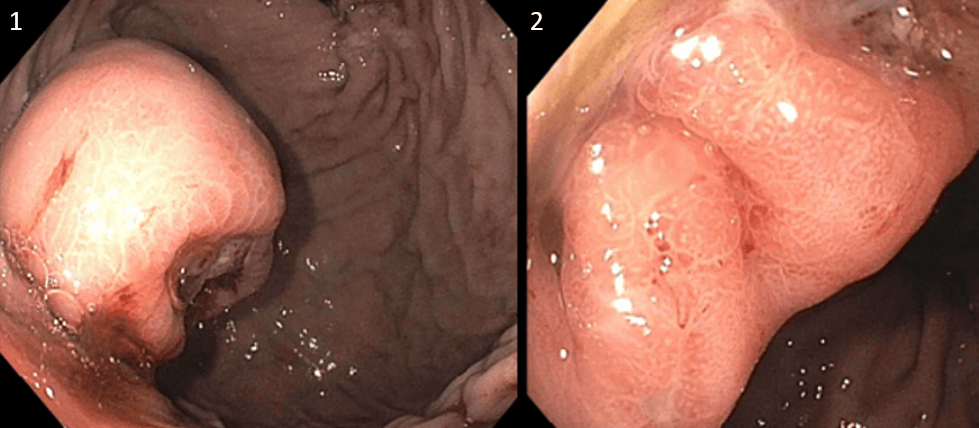Tuesday Poster Session
Category: Stomach and Spleen
P6410 - GIST in the Mist: A Tumor Hidden Behind Common Symptoms
Tuesday, October 28, 2025
10:30 AM - 4:00 PM PDT
Location: Exhibit Hall

Nakul Ganju, MD (he/him/his)
Department of Medicine, Howard University Hospital
Washington, DC
Presenting Author(s)
Nakul Ganju, MD1, Ahmed Mohamed Ebeid, MD2, Benedicta Arhinful, MD2, Abay Gobezie, MD2, Pinky Bai, MD2, Lakshmi Chirumamilla, MD2, Chukwunonso Ndulue, MD2, Justice Arhinful, MD2, Juan C. Santiago-Gonzalez, MD, MSc2, Angesom Kibreab, MD2
1Department of Medicine, Howard University Hospital, Washington, DC; 2Howard University Hospital, Washington, DC
Introduction: Gastrointestinal stromal tumors (GISTs), the most common mesenchymal neoplasms of the GI tract, arise from interstitial cells of Cajal. They typically affect the stomach or small intestine, with peak incidence in adults aged 60–74. Clinical presentation varies by tumor size and location, from incidental findings to symptoms like GI bleeding, abdominal pain, or weight loss. Diagnosis relies on imaging, endoscopy, histopathology, and immunohistochemical markers such as CD117 (c-KIT), DOG1, and CD34. Timely recognition and consistent follow-up are critical to prevent complications and optimize outcomes.
Case Description/
Methods: A 46-year-old male with GERD and a known hiatal hernia presented with acute epigastric pain, hematemesis, melena, and syncope. On admission, he was anemic (hemoglobin 7.8 g/dL). Contrast-enhanced CT showed a 4.8 cm enhancing mass along the stomach's greater curvature. Esophagogastroduodenoscopy identified a large (4–5 cm), ulcerated, non-actively bleeding gastric lesion. Biopsies confirmed spindle cell-type GIST, positive for CD117, DOG1, and CD34. He was stabilized and discharged on proton pump inhibitors, with plans for outpatient surgical follow-up; however, he was lost to follow-up. Six months later, he presented to another facility with worsening GI symptoms. Repeat imaging showed a persistent mass, and he underwent successful laparoscopic partial gastrectomy. Final pathology confirmed a 5.0 cm spindle cell GIST with low mitotic activity (4/5 mm²), negative margins, and classification as very low risk.
Discussion: This case highlights diagnostic and management challenges in GIST, particularly in younger patients where neoplastic causes may be underappreciated. Initial symptoms may have been misattributed to pre-existing GERD and hiatal hernia, underscoring the need for a broad differential in persistent or atypical GI presentations. Loss to follow-up delayed definitive management and led to recurrence of symptoms. This case reinforces the need for clinician vigilance, patient education, and structured follow-up. Multidisciplinary coordination among gastroenterology, surgery, and pathology is vital to ensure timely diagnosis, treatment, and surveillance. Adjuvant imatinib may be considered based on risk stratification.

Figure: Figure 1.
1: Endoscopic image of the gastric body demonstrating an ulcerated subepithelial mass arising from the greater curvature.
2: Close-up view of the same gastric mass, highlighting its lobulated contour and central mucosal ulceration with stigmata of recent bleeding—features suggestive of a gastrointestinal stromal tumor (GIST).

Figure: Figure 2.
Histopathologic section of the gastric mass stained with hematoxylin and eosin (H&E), demonstrating spindle-shaped tumor cells arranged in intersecting fascicles, characteristic of the spindle cell subtype of gastrointestinal stromal tumor (GIST).
Disclosures:
Nakul Ganju indicated no relevant financial relationships.
Ahmed Mohamed Ebeid indicated no relevant financial relationships.
Benedicta Arhinful indicated no relevant financial relationships.
Abay Gobezie indicated no relevant financial relationships.
Pinky Bai indicated no relevant financial relationships.
Lakshmi Chirumamilla indicated no relevant financial relationships.
Chukwunonso Ndulue indicated no relevant financial relationships.
Justice Arhinful indicated no relevant financial relationships.
Juan Santiago-Gonzalez indicated no relevant financial relationships.
Angesom Kibreab indicated no relevant financial relationships.
Nakul Ganju, MD1, Ahmed Mohamed Ebeid, MD2, Benedicta Arhinful, MD2, Abay Gobezie, MD2, Pinky Bai, MD2, Lakshmi Chirumamilla, MD2, Chukwunonso Ndulue, MD2, Justice Arhinful, MD2, Juan C. Santiago-Gonzalez, MD, MSc2, Angesom Kibreab, MD2. P6410 - GIST in the Mist: A Tumor Hidden Behind Common Symptoms, ACG 2025 Annual Scientific Meeting Abstracts. Phoenix, AZ: American College of Gastroenterology.
1Department of Medicine, Howard University Hospital, Washington, DC; 2Howard University Hospital, Washington, DC
Introduction: Gastrointestinal stromal tumors (GISTs), the most common mesenchymal neoplasms of the GI tract, arise from interstitial cells of Cajal. They typically affect the stomach or small intestine, with peak incidence in adults aged 60–74. Clinical presentation varies by tumor size and location, from incidental findings to symptoms like GI bleeding, abdominal pain, or weight loss. Diagnosis relies on imaging, endoscopy, histopathology, and immunohistochemical markers such as CD117 (c-KIT), DOG1, and CD34. Timely recognition and consistent follow-up are critical to prevent complications and optimize outcomes.
Case Description/
Methods: A 46-year-old male with GERD and a known hiatal hernia presented with acute epigastric pain, hematemesis, melena, and syncope. On admission, he was anemic (hemoglobin 7.8 g/dL). Contrast-enhanced CT showed a 4.8 cm enhancing mass along the stomach's greater curvature. Esophagogastroduodenoscopy identified a large (4–5 cm), ulcerated, non-actively bleeding gastric lesion. Biopsies confirmed spindle cell-type GIST, positive for CD117, DOG1, and CD34. He was stabilized and discharged on proton pump inhibitors, with plans for outpatient surgical follow-up; however, he was lost to follow-up. Six months later, he presented to another facility with worsening GI symptoms. Repeat imaging showed a persistent mass, and he underwent successful laparoscopic partial gastrectomy. Final pathology confirmed a 5.0 cm spindle cell GIST with low mitotic activity (4/5 mm²), negative margins, and classification as very low risk.
Discussion: This case highlights diagnostic and management challenges in GIST, particularly in younger patients where neoplastic causes may be underappreciated. Initial symptoms may have been misattributed to pre-existing GERD and hiatal hernia, underscoring the need for a broad differential in persistent or atypical GI presentations. Loss to follow-up delayed definitive management and led to recurrence of symptoms. This case reinforces the need for clinician vigilance, patient education, and structured follow-up. Multidisciplinary coordination among gastroenterology, surgery, and pathology is vital to ensure timely diagnosis, treatment, and surveillance. Adjuvant imatinib may be considered based on risk stratification.

Figure: Figure 1.
1: Endoscopic image of the gastric body demonstrating an ulcerated subepithelial mass arising from the greater curvature.
2: Close-up view of the same gastric mass, highlighting its lobulated contour and central mucosal ulceration with stigmata of recent bleeding—features suggestive of a gastrointestinal stromal tumor (GIST).

Figure: Figure 2.
Histopathologic section of the gastric mass stained with hematoxylin and eosin (H&E), demonstrating spindle-shaped tumor cells arranged in intersecting fascicles, characteristic of the spindle cell subtype of gastrointestinal stromal tumor (GIST).
Disclosures:
Nakul Ganju indicated no relevant financial relationships.
Ahmed Mohamed Ebeid indicated no relevant financial relationships.
Benedicta Arhinful indicated no relevant financial relationships.
Abay Gobezie indicated no relevant financial relationships.
Pinky Bai indicated no relevant financial relationships.
Lakshmi Chirumamilla indicated no relevant financial relationships.
Chukwunonso Ndulue indicated no relevant financial relationships.
Justice Arhinful indicated no relevant financial relationships.
Juan Santiago-Gonzalez indicated no relevant financial relationships.
Angesom Kibreab indicated no relevant financial relationships.
Nakul Ganju, MD1, Ahmed Mohamed Ebeid, MD2, Benedicta Arhinful, MD2, Abay Gobezie, MD2, Pinky Bai, MD2, Lakshmi Chirumamilla, MD2, Chukwunonso Ndulue, MD2, Justice Arhinful, MD2, Juan C. Santiago-Gonzalez, MD, MSc2, Angesom Kibreab, MD2. P6410 - GIST in the Mist: A Tumor Hidden Behind Common Symptoms, ACG 2025 Annual Scientific Meeting Abstracts. Phoenix, AZ: American College of Gastroenterology.
